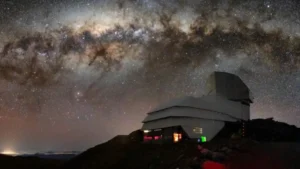On April 8, there will be a total solar eclipse. The rare event will be visible to millions across the U.S., Canada, and Mexico. They will witness the afternoon slip into darkness for approximately four minutes.
“This is going to be the most populated eclipse in the U.S., with 31.5 million people able to just walk outside of their homes and experience this event,” NASA representative Kelly Korreck said in a news conference.
The Sun’s atmosphere
During a total eclipse, the Moon completely covers the Sun. We will be able to see the corona of the Sun and its outer atmosphere. It is never normally visible because the Sun is so bright. But when the Moon blocks the Sun, the corona is clear. It should look like white ribbons around the edge.
Onlookers can see the corona during any solar eclipse, but this one is a little different. The Sun has a solar cycle, and every 11 years, the magnetic poles flip places. We are in the middle of this cycle, and the Sun’s activity is at its highest. Wisps from the corona should be much more distinct than they were during the 2017 solar eclipse.
As usual with an eclipse, any observer will need eye protection. No viewing with the naked eye.

The path of the 2024 solar eclipse. Photo: Great American Eclipse
The eclipse is of huge interest to researchers. They hope it will give greater insight into the Sun’s corona and the effect an eclipse has on Earth. NASA’s Parker Solar Probe aims to enter the corona multiple times to collect data, especially about the corona’s mysterious temperature. You would expect it to be cooler than the Sun because it is further away, yet it is hotter.
Scientists also hope to use the Parker Probe and several telescopes to capture images from various angles. From these images, they can study the corona’s magnetic fields.
How will it affect Earth?
In areas affected by the eclipse, the temperature will drop by around 10°C. It could also impact the photosynthesis of plants and stir nocturnal animals.
One research team will send hundreds of balloons 35km into the air. They will take measurements to see what impact the eclipse has on our atmosphere and weather.
Angela Des Jardins, who is leading the team, told Scientific American that they are particularly interested in how the drop in temperature will impact Earth’s gravity waves.
“Gravity waves are basically pressure waves in the atmosphere,” Des Jardins said. “They are important because they dominate the mixing in the atmosphere and the transport of energy. Understanding them in the scope of climate change is important.”
Another research team will look at how it impacts animal behavior. They are enlisting hundreds of volunteers to record the sounds of animals as the eclipse passes over.
A team of astronomers and cartographers has mapped the pathway of the eclipse. It will start over the Southern Ocean and then become visible in Mazatlán, Mexico, before heading across the U.S. from Texas to Maine. The pathway then stretches into Canada, starting in Southern Ontario and finishing in Newfoundland. From there, it will continue over the Atlantic. The expected pathway is 160km wide.
Apart from scientists, thousands of amateur but committed eclipse chasers are gearing up for the event. They are making reservations in multiple hotels along the eclipse path. A couple of days before the event, based on the weather, they will decide where to go. These rare eclipses are a big deal for those chasing the experience of “totality.”
The next total eclipse over the U.S. won’t occur until 2044.






